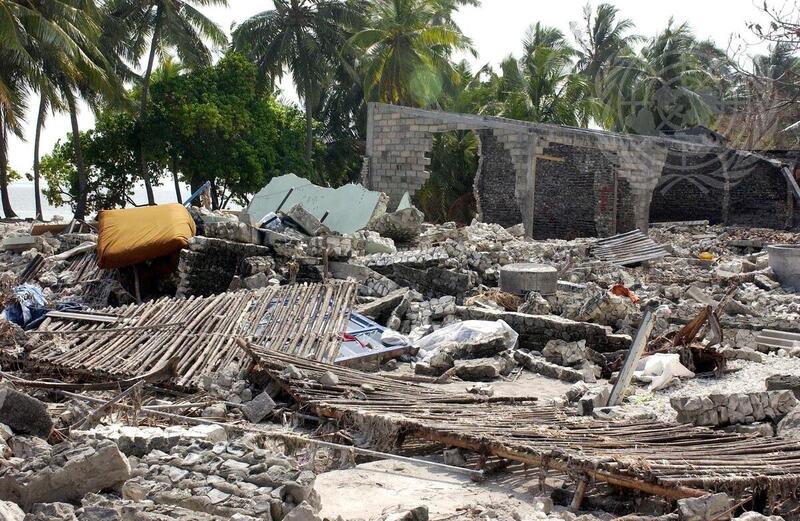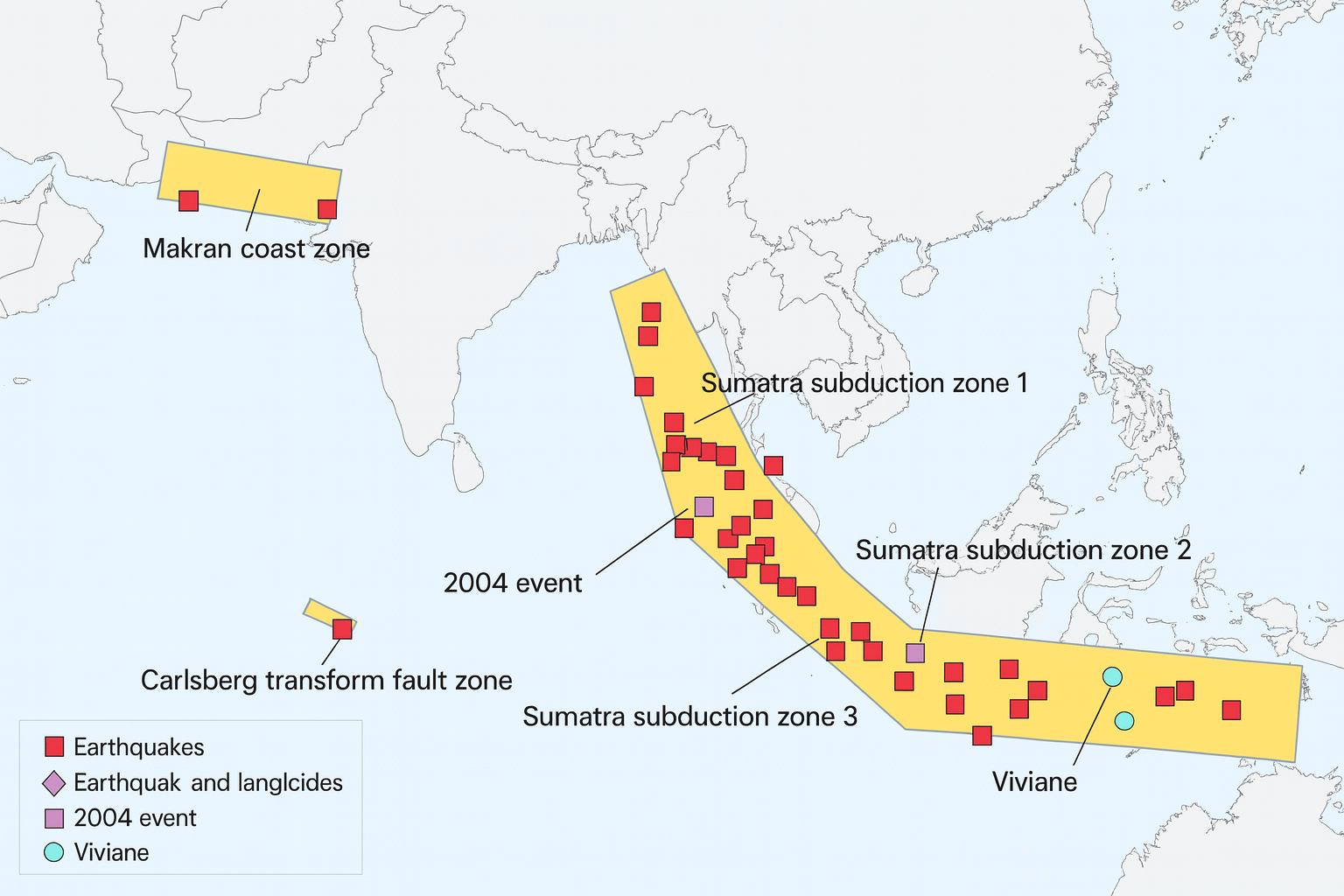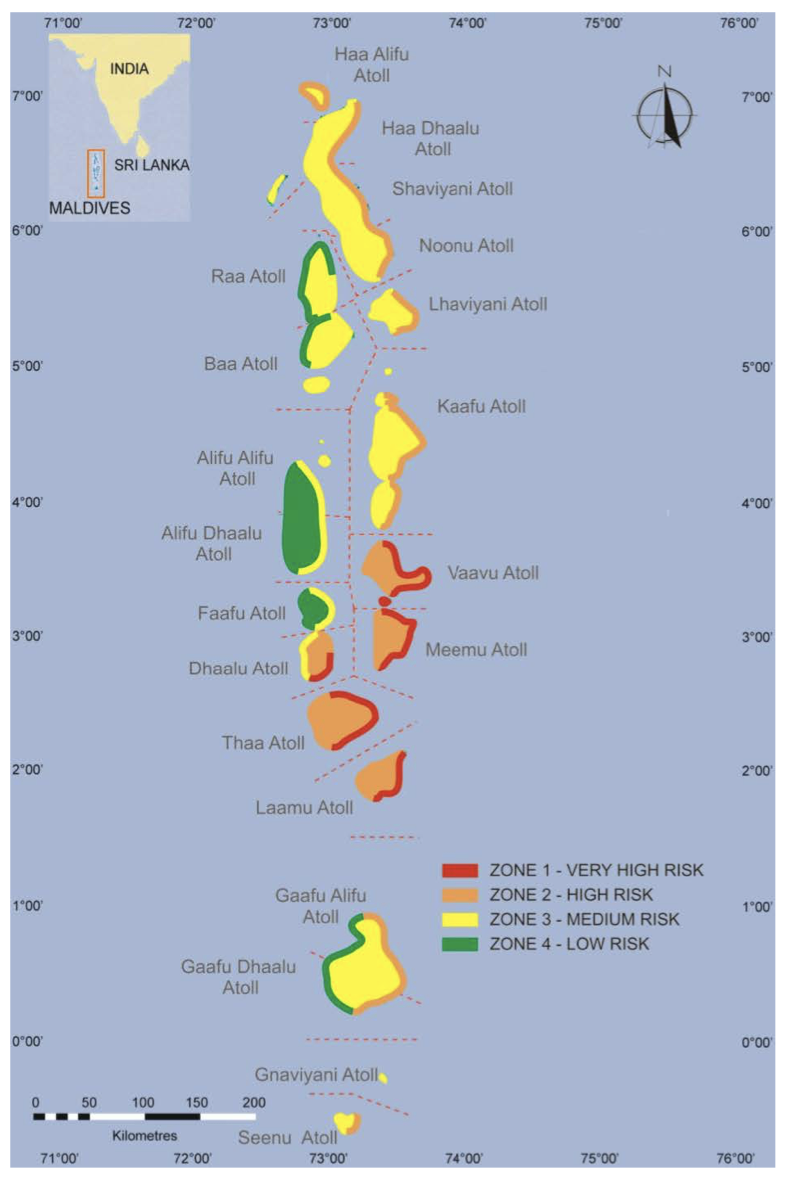What Is a Tsunami?
A tsunami is a series of very large ocean waves caused mainly by underwater earthquakes, volcanic eruptions, or landslides. These waves can travel across the ocean at high speed and become extremely dangerous when they reach shallow coastal areas.
In the Maldives, tsunamis are rare — but one major wave can flood many islands. The 2004 Indian Ocean Tsunami showed how even distant earthquakes can have severe effects, with flooding reported in every atoll and widespread damage to homes and infrastructure.
Because our islands are flat and close to the sea, it is important for everyone — whether living here or visiting — to know what to do when a tsunami warning is issued.

A view of Vilufushi island, on the southeastern Kolhumadulu Atoll, where 17 have died and 28 are still missing after the tsunami swept across their island. (Photo UN Maldives)
How Tsunamis Reach the Maldives
Tsunamis that affect the Maldives usually come from large earthquakes in the Indian Ocean. Scientists have identified three main zones where such earthquakes can happen:
The Sunda Trench (Indonesia): The main source of large tsunamis that can reach the Maldives within 3 to 4 hours.
The Makran Region (Iran–Pakistan): Has generated a few tsunamis in history; waves can reach the Maldives from the northwestern Indian Ocean.
The Carlsberg Ridge (southwest of Maldives): Rarely active but capable of generating small tsunamis.
The eastern and southern atolls are more exposed to tsunami waves because they face the open Indian Ocean, where these waves travel from. Central atolls may also experience strong flooding because of how underwater slopes and ridges focus the energy of the waves.

Locations of historic tsunami events and major source zones in the Indian Ocean, including the Makran coast, Carlsberg transform fault, and Sumatra subduction zones. The map highlights key earthquake-generated tsunami sources, including the 2004 Indian Ocean event. (Source: Developing a Disaster Risk Profile of the Maldives, 2004)
Tsunami Risk Zones in the Maldives
Different parts of the Maldives face different levels of tsunami risk. These depend on how close the islands are to open ocean and underwater slopes that can amplify waves.
Zone 1 – Very High Risk: Laamu, Thaa, Dhaalu, and Vaavu Atolls
Zone 2 – High Risk: Kaafu, Meemu, and Faafu Atolls
Zone 3 – Medium Risk: Baa, Raa, and Lhaviyani Atolls
Zone 4 – Low Risk: Northern atolls (Haa Alifu, Haa Dhaalu) and western atolls (parts of Gaafu Dhaalu)

Even if your island is in a low-risk zone, a large earthquake in the region can still cause flooding. Always treat every tsunami alert seriously.
Tsunami Alert Levels in the Maldives
The Maldives Meteorological Service (MMS) uses four color-coded alerts to warn people about tsunamis and other severe weather. Knowing what these colors mean can help you act quickly.
⚪ Alert White: Information
A strong earthquake has happened somewhere, but there is no threat yet.
Stay informed through MET and NDMA updates.
🟡 Alert Yellow: Advisory
A regional tsunami may cause moderate effects.
Stay away from the beach, check for updates, and be ready to move inland.
🟠 Alert Orange: Warning
A tsunami with possible high impact is expected.
Move immediately to safe areas or higher ground.
🔴 Alert Red: Severe Warning
A confirmed major tsunami is approaching.
Evacuate coastal areas at once and stay in shelters until it is declared safe.
Always take these alerts seriously. Do not wait to see the waves — act as soon as a warning is issued.
Know the Natural Warning Signs
Sometimes a tsunami can reach before an official alert is given. If you notice any of these signs, move immediately to higher ground or inland:
The ground shakes strongly or for a long time.
The ocean water pulls back suddenly, exposing the seabed or coral.
The sea rises unusually fast or you hear a loud roaring sound.
If you see or feel any of these, don’t wait for an announcement — go to safety immediately.
Before a Tsunami: Get Ready
Being prepared saves lives. Here’s what you can do now:
Learn your island’s safe zones. Know the evacuation routes and the nearest shelter. If your island is flat, identify solid buildings where upper floors can be used for safety.
Prepare a family emergency plan. Decide how you’ll communicate and where you’ll meet if separated.
Pack an emergency bag with clean water, flashlight, batteries, first aid, important documents, and basic food supplies.
Follow official alerts from the Maldives Meteorological Service (MET) and the National Disaster Management Authority (NDMA) on radio, TV, or social media.
Join drills and awareness sessions. Participate in tsunami evacuation practices organized by your council or community group.
Tourists should follow resort safety briefings and ask where their evacuation areas are located.
During a Tsunami: Act Fast
When a tsunami warning is announced or you see natural warning signs, act immediately.
Move quickly away from beaches, harbors, and lagoons.
Head inland or to higher ground.
Take only what you need — time is critical.
Help children, older persons, and visitors who may not know what to do.
If you are on a boat, move to deep water if it is safe and time allows.
If you are already at sea, stay offshore until authorities say it is safe to return.
Stay calm, follow the instructions of local councils, NDMA officials, or resort staff, and do not go back until it’s declared safe.
After a Tsunami: Stay Safe
Even after the first wave, danger may not be over — multiple waves can come hours apart.
Stay in safe areas until NDMA or MET confirm it’s safe to return.
Avoid walking or driving in floodwater; it may hide sharp debris or electric wires.
Check on neighbors and assist people who may be injured.
Report damage to your island council or resort management.
Do not enter damaged buildings until they are inspected for safety.
Take photos of damage for insurance or aid purposes.
Remain alert to new announcements in case of additional waves or weather hazards.
Stay Prepared, Stay Safe
Tsunamis cannot be stopped — but with awareness and quick action, their impact can be reduced.
Every island resident, community leader, and visitor has a role to play. Know your evacuation route, follow official alerts, and help those around you. The Maldives has faced the ocean’s power before and continues to stand strong through preparedness and unity.
When you know what to do, you can save your life — and the lives of others.